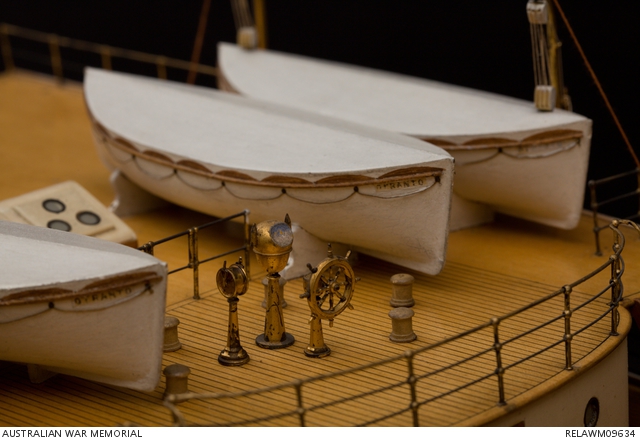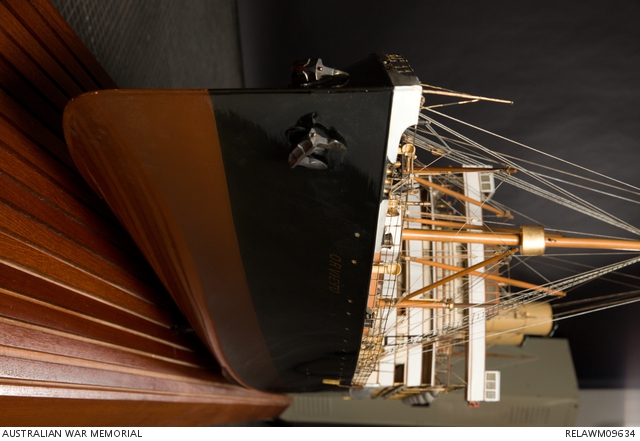| Accession Number | RELAWM09634 |
|---|---|
| Collection type | Technology |
| Object type | Model |
| Physical description | Brass, Celluloid, Cotton, Wire, Wood |
| Location | Main Bld: First World War Gallery: Australia Goes To War: The AIF Dispatched |
| Maker |
Workman Clark & Company |
| Place made | United Kingdom: Northern Ireland, Belfast |
| Date made | c 1909 |
| Conflict |
First World War, 1914-1918 |
Model Ship: HMAT Orvieto

















































Large wooden hulled maker's model of the Royal Mail Ship Orvieto. The model is finished in enamel paints in the livery of the Orient Steam Navigation Company, the lower hull below the waterline in an anti-fouling red; the upper hull in black; the outer faces of the superstructure in white; and the funnels and cowl vents in a yellow cream. All decks are natural wood - a veneer inked with a plank pattern. The convoy number 'A 3', printed on a thick paper label, is affixed to the starboard upper hull between the main mast and the bridge. There is no number on the port side hull. The number 'A 3' is also painted in black on the sides of the port and starboard bridge wings. There are three levels of brass portholes with celluloid glazing arrayed along the hull.
The forward deck is equipped with brass anchor capstans, chains and anchors; with wooden hold covers; and with the main mast. This is fitted with a brass crows nest, access ladders, bell and navigation lights; cotton Jacob's ladders and rigging, and with brass and celluloid blocks and pulleys. There are a pair of large wooden cargo crane arms located either side of the mast, with associated brass pulleys and blocks and cotton rigging and lashing ropes; and a pair of smaller brass deck cranes just forward of the main bridge. There are eight small brass cowl vents lined along the forward deck. Four sets of wooden accommodation ladders, with platforms, are lashed in the stored position to the upper hull side adjacent to the deck cranes.
The main superstructure consists of a raised wheelhouse, bridge and wings, an upper deck and two lower decks. There are two wooden funnels, each equipped with brass ladders, vents and piping, with cotton funnel stays. Five sets of large and medium brass cowl vents are arrayed down the upper deck. The bridge is fitted with brass binnacles and compass, and is equipped with celluloid windows with brass frames. Brass pilot lights are sited on the outer sides of the bridge wings, with painted red (port) and green (starboard) borders. Behind the bridge are raised skylights with celluloid and brass frames. Each side of the upper deck is fitted with six large lifeboats and one small wooden lifeboat, each carved from wood to include their covers; and each mounted on brass davits with celluloid lifting blocks. The upper and lower decks are provided with soldered brass railings with wooden cappings. There are four sets of internal companion-ways running down from the upper deck, and sets of external ladders running from these to the lower deck.
The rear deck is fitted with a small mast with similar but smaller versions of the cotton Jacobs ladders, wooden crane arms, brass bocks and tackles as the font mast. Four large lifeboats and their davits are mounted on the upper rear deck, along with the rear steering gear - a brass wheel, binnacle and compass. There is a jackstaff at the stern.
The model mounts a pair of large three-bladed brass screws and a hinged brass rudder. There are supporting pedestals attached to the underneath of the hull, in three sets of two, for display purposes.
The 12,130 ton 'Orvieto' was built in the shipyards of Workman Clark & Company at Belfast for the Orient Steam Navigation Company, and launched on 6 July 1909. As a Royal Mail Ship and passenger vessel, RMS 'Orvieto' commenced runs from England to Brisbane, Australia on 26 November that year. At the start of the First World War, the ship was requisitioned by the Australian Government and fitted out as a troop transport in Sydney in 1914, with a capacity for 209 officers, 1,425 men and 22 horses. Designated as the flagship of the First Convoy, and carrying Major General Bridges and the staff of 1 Division, and newly-appointed official correspondent Charles Bean among others, His Majesty's Australian Transport (HMAT) 'Orvieto' left Sydney in mid October, bearing Convoy number A3. The entire convoy was assembled at Albany, WA, and sailed on 1 November 1914, the 'Orvieto' leading the convoy of 36 transports to Egypt, setting its speed and course; at Colombo, the ship took on board prisoners from the German raider SMS Emden, including the commander, Captain Karl von Muller, who had been captured after the ship's defeat by HMAS Sydney off Cocos Island.
Australian Commonwealth control of the 'Orvieto' ended on 29 December, after the troops and prisoners were disembarked at Egypt. The 'Orvieto' then sailed to London in preparation for another England-Australia voyage. Instead, it was requisitioned by the Admiralty and fitted out as an armed merchant cruiser with eight 6 inch guns. As HMS 'Orvieto', the ship operated as a minelayer and was involved in the interception and capture of over 30 foreign merchantmen. The ship was returned to the Orient Steam Navigation Company at the end of 1918 and returned to England-Brisbane mail run for the next eleven years. The 'Orvieto' was sold for scrap and broken up in 1931/32.
This 1:48 scale (1/4 inch to the foot) builder's model of the 'Orvieto' as an Australian transport was acquired by the Australian War Memorial in 1926 as the result of a request to the Sydney offices of the Orient Steam Navigation Company on 26 April 1926. The Australian manager of the Company, Mr Anderson, forwarded this request to his London managers, who responded a month later that they were 'glad to offer of model of the 'Orvieto' with some particulars of her war services'. Arrangements were made for the model to be shipped from the company's Colombo offices, where it was then displayed, to Melbourne, where the War Memorial was preparing to open a temporary exhibition at the Exhibition Buildings on 1 October 1927.
Permission was requested and granted from Australian Customs for the Memorial’s carter to take direct delivery of the model from the S.S. 'Oronsay' at Princes Pier, Port Melbourne when the ship docked on 22 November 1926. Duly delivered to the Exhibition Building, the model of the 'Orvieto' was inspected and later prepared for display in 1927. Prior to the opening, the then manager of the Orient Steam Navigation Company, Major R H Norman was invited to inspect the display. He wrote on 12 September to suggest that the model should be repainted ‘in accordance with the colour adopted during her employment as a transport before display’. While this was agreed to be a good idea, there was no time to undertake the painting prior to the exhibition opening, and apart from the addition of the ship’s transport number (A3) to the bridge wings and the starboard hull, the model has remained in its original civilian finish.